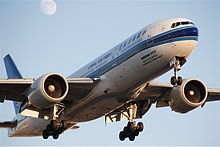Air route authority between the United States and China
Due to the highly regulated nature of awards for route authority between the two countries and the strict limits on number of flights, the application process is competitive.
However, there is an air service agreement between the American Institute in Taiwan and the Taipei Economic and Cultural Representative Office in the United States.
Its application to operate twice-per-week Seattle–Tokyo–Shanghai flight starting May 2 was approved by CAAC before U.S. President Ronald Reagan's state visit to China.
[46] (the route was later re-instated on July 1, 2011, under the Delta Air Lines brand) Northwest Airlines then became the only airline authorized to fly China that did not offer any non-stop service to that country until it resumed non-stop flights between Detroit and Shanghai on June 1, 2009 (as part of its new parent, Delta Air Lines).
China Southern Airlines inaugurated the non-stop flight from Guangzhou to Los Angeles on July 20, 1997, using a Boeing 777-200ER aircraft.
Delta re-instated the Atlanta to Shanghai route on June 5, 2011, operating 2 days a week, as part of the carrier's international expansion for 2011.
[52] United Airlines gained additional frequencies under this agreement and, in April 2000, started non-stop Shanghai-San Francisco service.
[51] The 2004 agreement led to the 2005 expansion of flights between the two countries as well as new service by Northwest Airlines from Tokyo to Guangzhou, which began on November 1, 2004, operated using Boeing 757 aircraft.
In a hint of the DOT's decision-making process and preferences, it stated in its report intention to grant Continental and American Airlines route authority that "this tentatively leaves seven frequencies to be awarded ... Delta and Northwest."
[72] The Atlanta–Shanghai Delta service was suspended on September 1, 2009, but was re-instated on June 5, 2011; the route, however, ceased again on January 17, 2012, due to poor loads.
[82] On January 15, 2013, Air China announced its plans to launch non-stop service between Houston and Beijing, beginning Thursday, July 11, 2013, pending approval from the United States Department of Transportation.
Hainan also initiated service to both Boston and Seattle from Shanghai, becoming the first Chinese airline to fly to North America from more than one base in mainland China.
[97] On September 22, 2015, United Airlines announced that it is seeking regulatory approval to begin seasonal flights between its San Francisco hub and the interior Chinese city of Xi'an, effective May 2016.
[100] On March 9, 2016, United announced that it would launch service to the Chinese city Hangzhou from San Francisco, the airline's fifth destination in mainland China.
[103] On September 29, China Eastern Airlines commenced non-stop service between San Francisco and its growing base in Qingdao.
The route was previously marketed as a one-stop flight via Shanghai-Pudong but was transitioned to a 3 time weekly non-stop service on their A330-200 aircraft.
[107] On October 21, 2017, Hainan Airlines launched non-stop service between New York's John F. Kennedy International Airport (JFK) and Chongqing.
On October 27, 2017, Hainan Airlines launched non-stop service between New York's John F. Kennedy International Airport (JFK) and Chengdu.
[111] On October 22, 2018, Delta Airlines announced it would seek DOT approval for direct service between Minneapolis-St. Paul International Airport and Shanghai beginning in June 2020 using an A350.
[112] On November 2, 2018, United Airlines announced it would seek DOT approval for a second daily nonstop flight from its New York City/Newark hub to Shanghai, to begin in June 2020 using a Boeing 777-200.
[113] On February 13, 2018, CAAC approved China Southern Airlines' application for direct service between Wuhan Tianhe International Airport and New York/JFK, to begin in June 2019.
[114] The passenger air transportation demand between China and the United States were significantly decreased due to the COVID-19 pandemic outbreak in late January 2020.
The pattern established by the notice was being called "Five-Ones" Policy, which allowed each Chinese airline to maintain one route to any specific country with no more than one flight per week; the foreign airlines are only allowed to maintain one route to China with no more than one weekly flight, on the basis of schedules approved by CAAC on March 12.
Chinese Foreign Ministry denounced this restriction on May 25; on the same day, CAAC submitted a letter to the USDOT, which urged DOT to revoke the Order and insisted on the position that the "Five-Ones" policy is not inconsistent with the 1980 Agreement since it "equally applies to all domestic and international air carriers".
As a response, USDOT issued an order on Aug 18 that allows the increasing round-trip flights operated by four Chinese airlines that currently perform scheduled passenger services to the United States to eight weekly.
However, David Short, the deputy assistant secretary for aviation and international affairs of USDOT, said the US was still "not satisfied" with that since the previous bilateral agreement on air route authority does not provide any provisions about the Pandemic.
[131][132] On August 6, 2021, CAAC mandated a 40% capacity for 4 weeks on United Airlines 857 to Shanghai starting Aug 11 after it previously alleged five passengers tested positive for COVID-19 upon arrival on July 21, based on its "circuit breaker" policy.
[140] On January 8, 2023, China eased its entry restrictions and no longer requires people entering the country to be quarantined but the rate of flight recovery remained slow.
[159] On October 27, 2023, USDOT issued the Order 2023-10-9 that allows the quotas for the number of weekly flights operated by Chinese carriers increase from 24 to 35 starting November 9.
[161] On February 26, 2024, USDOT issued the Order 2024-2-21 that allows the quotas for the number of weekly flights operated by Chinese carriers increase from 35 to 50 starting March 31.










